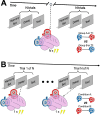Advancing working memory research through cortico-cortical transcranial magnetic stimulation
- PMID: 39717149
- PMCID: PMC11663928
- DOI: 10.3389/fnhum.2024.1504783
Advancing working memory research through cortico-cortical transcranial magnetic stimulation
Abstract
The neural underpinnings of working memory (WM) have been of continuous scientific interest for decades. As the understanding of WM progresses and new theories, such as the distributed view of WM, develop, the need to advance the methods used to study WM also arises. This perspective discusses how building from the state-of-the-art in the field of transcranial magnetic stimulation (TMS), and utilising cortico-cortical TMS, may pave the way for testing some of the predictions proposed by the distributed WM view. Further, after briefly discussing current barriers that need to be overcome for implementing cortico-cortical TMS for WM research, examples of how cortico-cortical TMS may be employed in the context of WM research are provided, guided by the ongoing debate on the sensory recruitment framework.
Keywords: ccPAS; cortico-cortical; paired associative stimulation; sensory recruitment; transcranial magnetic stimulation; working memory.
Copyright © 2024 Phylactou, Konstantinou and Ester.
Conflict of interest statement
The authors declare that the research was conducted in the absence of any commercial or financial relationships that could be construed as a potential conflict of interest.
Figures


Similar articles
-
Can we manipulate brain connectivity? A systematic review of cortico-cortical paired associative stimulation effects.Clin Neurophysiol. 2023 Oct;154:169-193. doi: 10.1016/j.clinph.2023.06.016. Epub 2023 Jul 7. Clin Neurophysiol. 2023. PMID: 37634335
-
Influence of frontal-to-parietal connectivity in pseudoneglect: A cortico-cortical paired associative stimulation study.Cortex. 2023 Dec;169:50-64. doi: 10.1016/j.cortex.2023.08.012. Epub 2023 Sep 28. Cortex. 2023. PMID: 37862830
-
Gradual enhancement of corticomotor excitability during cortico-cortical paired associative stimulation.Sci Rep. 2022 Aug 29;12(1):14670. doi: 10.1038/s41598-022-18774-9. Sci Rep. 2022. PMID: 36038605 Free PMC article.
-
Cortico-cortical and motor evoked potentials to single and paired-pulse stimuli: An exploratory transcranial magnetic and intracranial electric brain stimulation study.Hum Brain Mapp. 2016 Nov;37(11):3767-3778. doi: 10.1002/hbm.23274. Hum Brain Mapp. 2016. PMID: 27312488 Free PMC article.
-
Transcranial magnetic stimulation of the brain: What is stimulated? - A consensus and critical position paper.Clin Neurophysiol. 2022 Aug;140:59-97. doi: 10.1016/j.clinph.2022.04.022. Epub 2022 May 18. Clin Neurophysiol. 2022. PMID: 35738037 Free PMC article. Review.
References
-
- Bevacqua N., Turrini S., Fiori F., Saracini C., Lucero B., Candidi M., et al. . (2024). Cortico-cortical paired associative stimulation highlights asymmetrical communication between rostral premotor cortices and primary motor cortex. Brain Stimulat. 17, 89–91. doi: 10.1016/j.brs.2024.01.001 - DOI - PubMed
LinkOut - more resources
Full Text Sources
Research Materials

